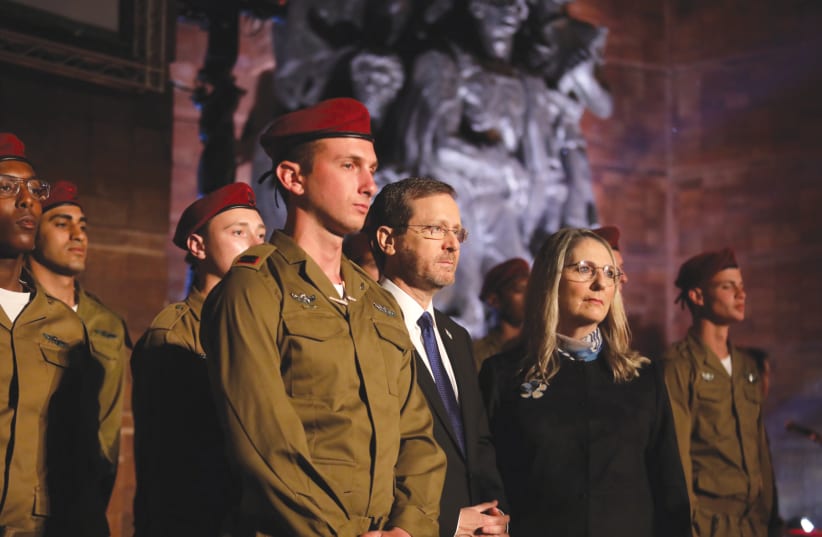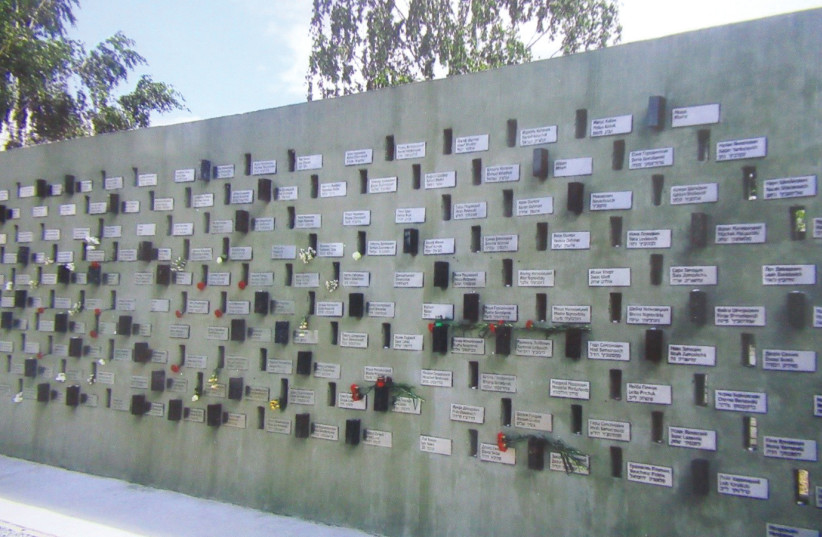On the eve of Holocaust Remembrance Day: Warsaw Ghetto Square of Yad Vashem is crowded with survivors, dignitaries and foreign media. We are in the midst of the period when the Warsaw Ghetto Uprising took place, from April 19-May 6, 1943. The uprising is prominently mentioned in the speech by the President of the State of Israel, Isaac Herzog.
I suddenly feel a personal connection to the Polish capital, a city that I never visited, as well as to a rebellion in which none of my family members participated. I reflect on the probability that I am here today because of the uprising that occurred far away from where my mother was interned at the time in a forced labor camp in Novogrudok, then Poland, today Belarus. I also reflect on the distinct probability that the uprising may never have happened if not for previously spread false rumors of a rebellion that never happened - in Novogrudok itself.
It is indeed a little-known and fascinating tale that involves a fabricated uprising in Novogrudok, which became influential in motivating the residents of the Warsaw Ghetto to rise up against their German oppressors. In turn, the uprising in Warsaw likely encouraged the labor camp inmates in Novogrudok to embark upon their escape in what was the greatest prisoner escape of World War II through a hand-dug tunnel, as well as possibly the most successful Holocaust escape at large.
My mother, Fania Dunetz Brodsky, climbed out of that tunnel with at least 225 others in order to escape to the Bielski partisan detachment, where she remained until her July 1944 liberation from the forest. Without the uprising and without the ensuing escape, it is unlikely that she would have survived the war, nor would she have seen children, grandchildren, and great-grandchildren. The story of the tunnel escape and the story of my mother have previously been published in the November 25, 2020, issue of this magazine.
I first became aware of the connection between the uprising and the Novogrudok tunnel escape during a memorial meeting of Novogrudok survivors and their descendants several years ago in Tel Aviv. There the esteemed Holocaust scholar Professor Yehuda Bauer told the story that he and others have written about. The slogan “Novogrudok is calling” is said to have resonated throughout the Warsaw Ghetto following an article penned by Eliezer Geller, who headed the Gordonia youth movement. A branch of the Hechalutz movement, Gordonia aimed to train pioneers for immigration to Palestine and collective labor in kibbutzim. Adapting scout-like activities to the confines of the ghetto, Geller also maintained an underground press called Slowo Mlocych (“The Voice of the Young”). There in March 1942 he published the following rumor of a purported rebellion in Novogrudok against the German captors:
Only in Novogrudok did the Jews know how to die with honor and to Avenge their bloodshed by the hand of their enemies. Only there, togetherWith the innocent victims, local gendarmes were killed while carrying outTheir murderous work. The city of Novogrudok has turned into a symbol For the Jews languishing in the hands of the Hitlerite murderers and aSymbol of heroism for our generation and generations to come.
This item was soon copied by the underground newspapers of both Hashomer Hatza’ir and the left-wing Poalei Zion organizations. The article in Jutrznia, Hashomer Hatza’ir’s underground ghetto newspaper, appeared on March 28, 1942, bearing the title: “The Heroes of Novogrudok.” There the rumor of a rebellion in Novogrudok was repeated, now with a report of 200 Jews rebelling and 20 Germans killed.
Professor Ruben Feldchu was a member of the Zionist right and a prolific chronicler of daily life in the Warsaw Ghetto. He was also one of the few Warsaw Ghetto diarists to survive the war, and in all likelihood, the only one to write in Hebrew. In spite of managing to salvage more than 800 pages of notes during his escape from the ghetto after one year in hiding, and his difficult immigration to pre-state Palestine, very little of his writings have been published. His biographer, Laurence Weinbaum, notes that in the spring of 1942, approximately one year before the uprising, Feldchu recorded the rumor that his fellow co-religionists in Novogrudok had staged a rebellion against their oppressors, when such a rebellion had not taken place.
In his book, The Jews of Belorussia During World War II,” Holocaust historian Shalom Cholawsky claims that it is “impossible to exaggerate the importance of such ‘news’ for the youth of the Warsaw Ghetto of March 1942.” He writes that “this story, as it was published, was a powerful legend influencing the underground and shaping the psychological mood in the Warsaw Ghetto.”
Who promulgated the myth of rebellion in Novogrudok which had not yet taken place? Both Cholawsky and famed historian Emmanuel Ringelblum, who also chronicled events in the Warsaw Ghetto, attribute the spreading of the false rumor to non-Jews. Ringelblum credits the P.P.R. (Polska Partia Robotnicza), or Polish Workers’ Party, as having encouraged rebellion against the Germans, and quotes a passage published in the Party’s underground paper on September 2, 1942, in which a call is made for Jews to match the resistance of the non-Jewish population:
The invaders are merciless and relentless. The Jewish population should be equally unrelenting in defending its existence…Only uncompromising resistance in every situation, only action – and not passive waiting for the slaughter – can save possibly thousands and tens of thousands, though it may claim victims. Let the heroic resistance of Novogrudok and other towns serve as an example.
Cholawsky, by contrast, contends that the invention of the false Novogrudok rebellion was perpetuated in the Warsaw Ghetto by members of the Polish A.K. (Armia Krajowa), or Home Army, the dominant resistance movement. He asserts that the Novogrudok area contained the A.K.’s largest force, and that the city was home to the Polish national poet Adam Mickiewicz, “symbolizing the site of Polish national consciousness.” Cholawsky finds it logical that in their efforts to arouse the Polish masses in the capital, the battle cry “Novogrudok is calling” would be effective in its inherent insinuation that “even” the Jews in their ghettos did all in their power to physically resist the German oppression.
In support of his assumption that the A.K. had spread the false rumor of a Novogrudok rebellion, Cholawsky notes that some non-Jews who had attended the city’s Adam Mickiewicz High School had now become Home Army members. In meetings known to have taken place during the war with their Jewish friends, these young men learned of the Jews’ quest for weapons to avenge the atrocities committed against them and their families. Cholawsky surmises that this passion for armed resistance on the part of the Jews with whom they met was “almost certainly” passed on to the Warsaw Ghetto by A.K. members in Warsaw.
A circle appears to have been closed when news of the Warsaw Ghetto uprising penetrated the walls of the sealed forced labor camp in Novogrudok, 423 kilometers away. How could this possibly have happened? The answer appears to lie with the several clandestine radios in the labor camp, which played a crucial role in the inmates’ resistance efforts.
One radio was assembled by the 14-year-old brother of inmate Jankef (Yakov) Nevakovich. A radio technician employed by Camp Commander Reuter, this youngster, whose first name is unknown, was given a work pass that allowed him entry into the camp. Here he would risk his life to sneak electronic components into the attic where he assembled a one-way radio. In his Yad Vashem testimony, escapee and former Judenrat head Daniel Ostashinski reports that this makeshift radio enabled the resistance leaders to hear the news, primarily the BBC, and to remain informed of the up-to-date events of the war.
In addition, the inmate Jack Kagan describes a radio smuggled into the camp in a sack of flour in December 1942 by fellow inmate Ruvke Shabakovski, who had been dispatched to town by the commandant. This purloined radio, carefully concealed in a hole chiseled into a beam of the ghetto loft, is said to have enabled the camp resistance leaders to monitor world news.
Yet another radio is reported by Yehuda Bauer to have been smuggled into the labor camp in the summer of 1943. This valuable device is also reported to have allowed resistance leaders to learn of the Warsaw Ghetto uprising, greatly intensifying their determination to escape.
In yet another confirmation that Novogrudok Labor Camp inmates were able to clandestinely monitor the events of the war, Chaim Leibowitz, a former inmate and member of the committee that planned the escape, notes in a post-war testimony that committee members had learned from a radio receiver broadcast of the Warsaw Ghetto uprising that began just 19 days prior to Novogrudok’s fourth and final massacre on May 7, 1943. This news is certainly likely to have strengthened the labor camp inmates in their resolve to plan a breakout after the May 7 slaughter.
While they may have been inspired by the revolt in Warsaw, the resistance leaders inside the labor camp are unlikely to have known that the call for the uprising is likely to have started 18 months prior to the escape with the chant “Novogrudok is calling.” With a fabricated act of resistance leading to two very real ones, it is unknown whether either the Warsaw Ghetto rebellion or the Novogrudok tunnel escape would have happened in 1943 if not for the false rumor regarding what never actually happened in Novogrudok in 1942.
The rumor and ensuing rebellion are likely to have encouraged my mother and her fellow inmates to crawl out of the Novogrudok labor camp in their own quest for freedom. At least 128 lives were saved as a result. Having chosen life, it was against all odds that most of the survivors learned to love and trust again. They rebuilt their families and created new lives. To whoever started the rumor, I wish to express my gratitude. Thank you. ■
This article is based on research undertaken for the author’s upcoming book, Tunnel of Hope: Escape from the Novogrudok Forced Labor Camp, which includes a foreword by Yehuda Bauer. The book is dedicated to her mother, who gave the name Tunnel of Hope to the 2015 documentary film about the breakout, in which she participated.

